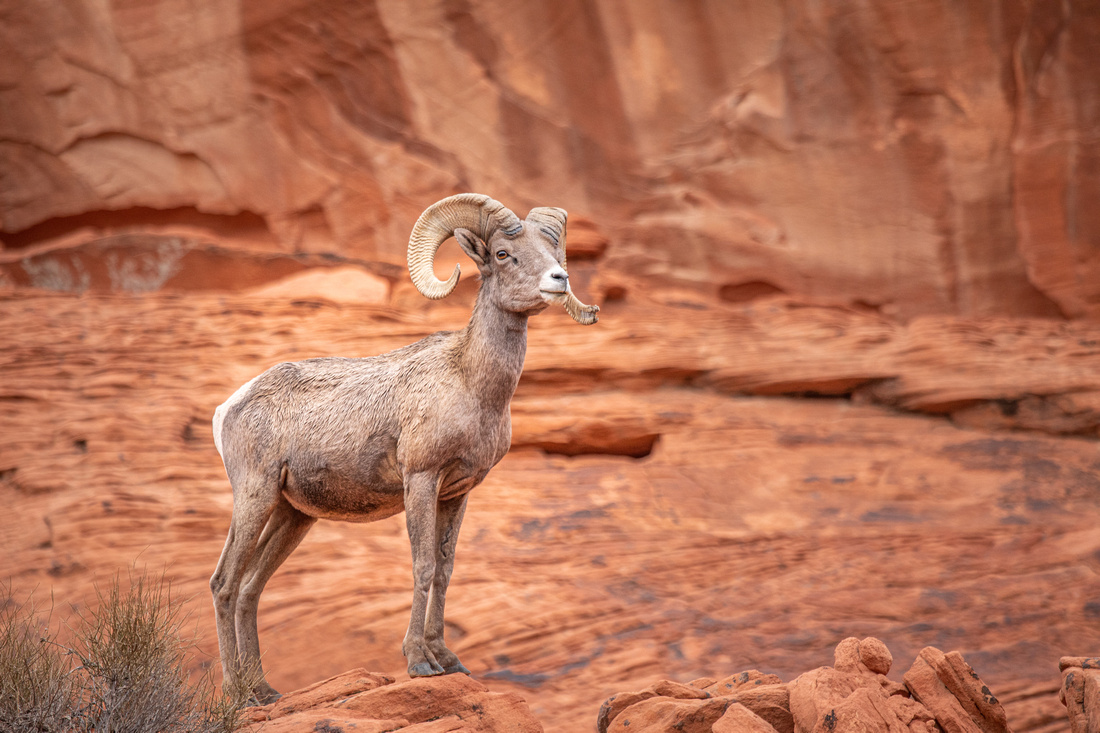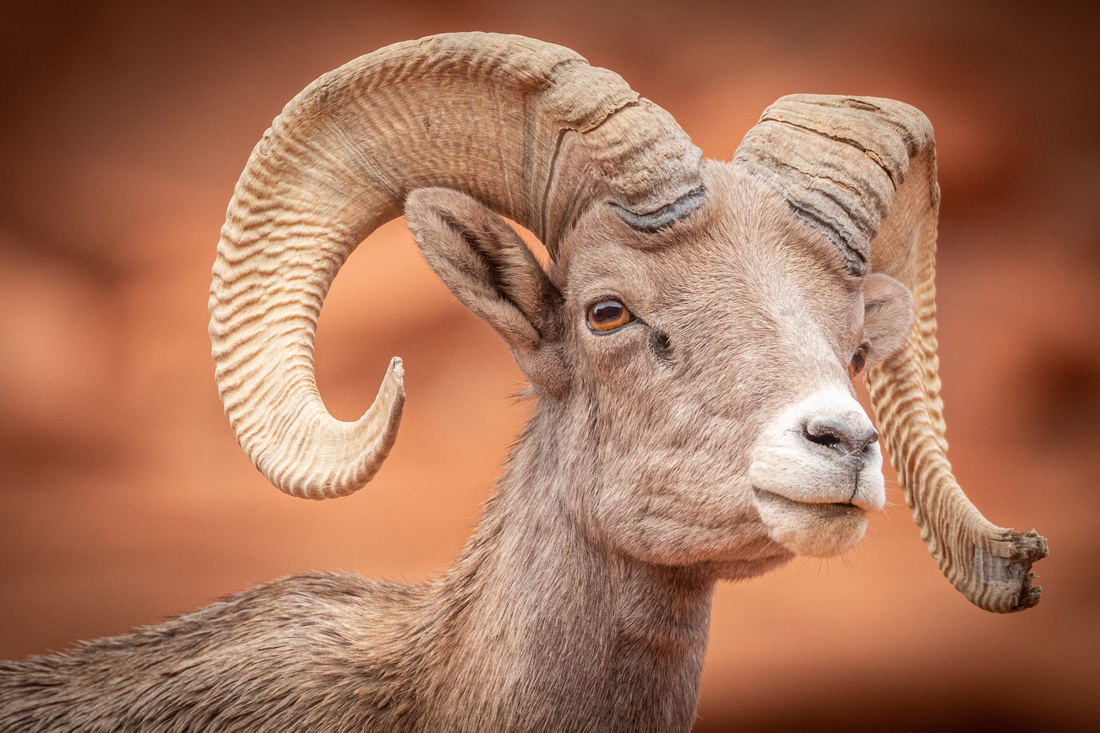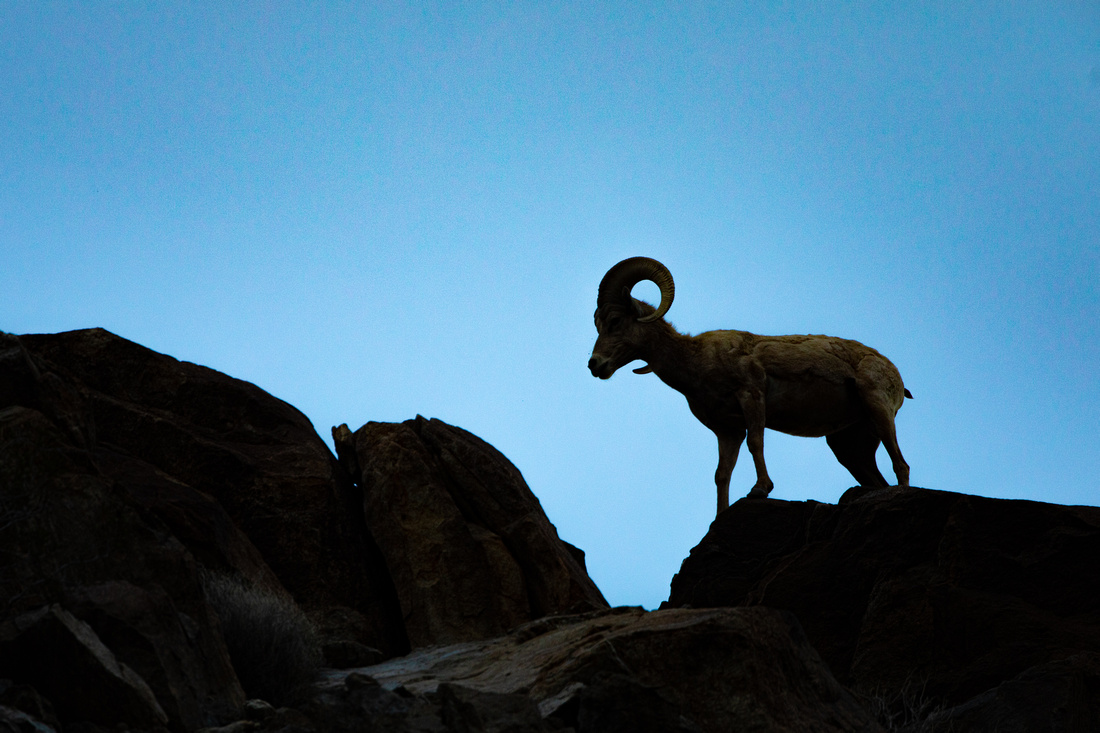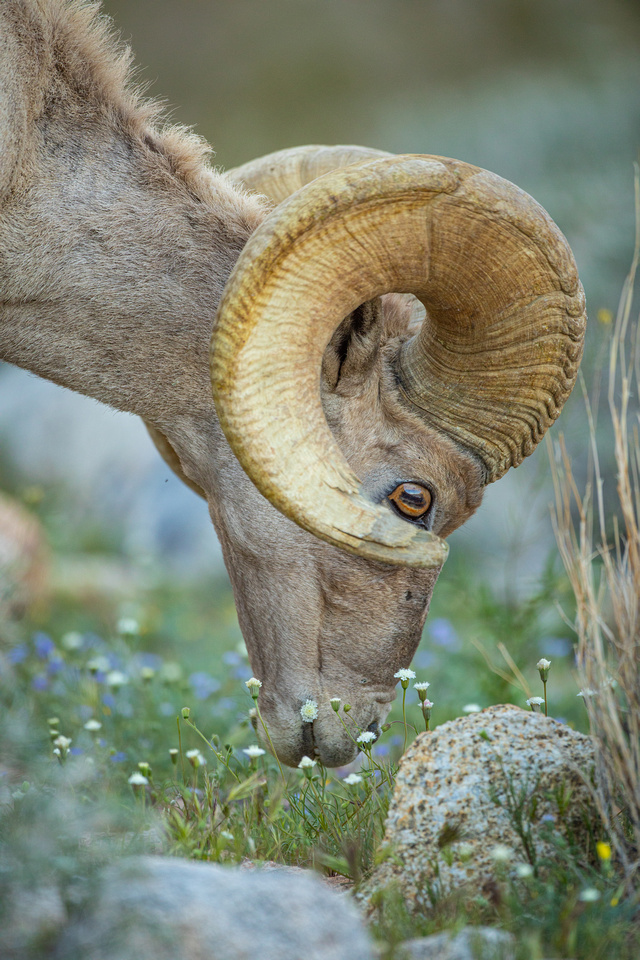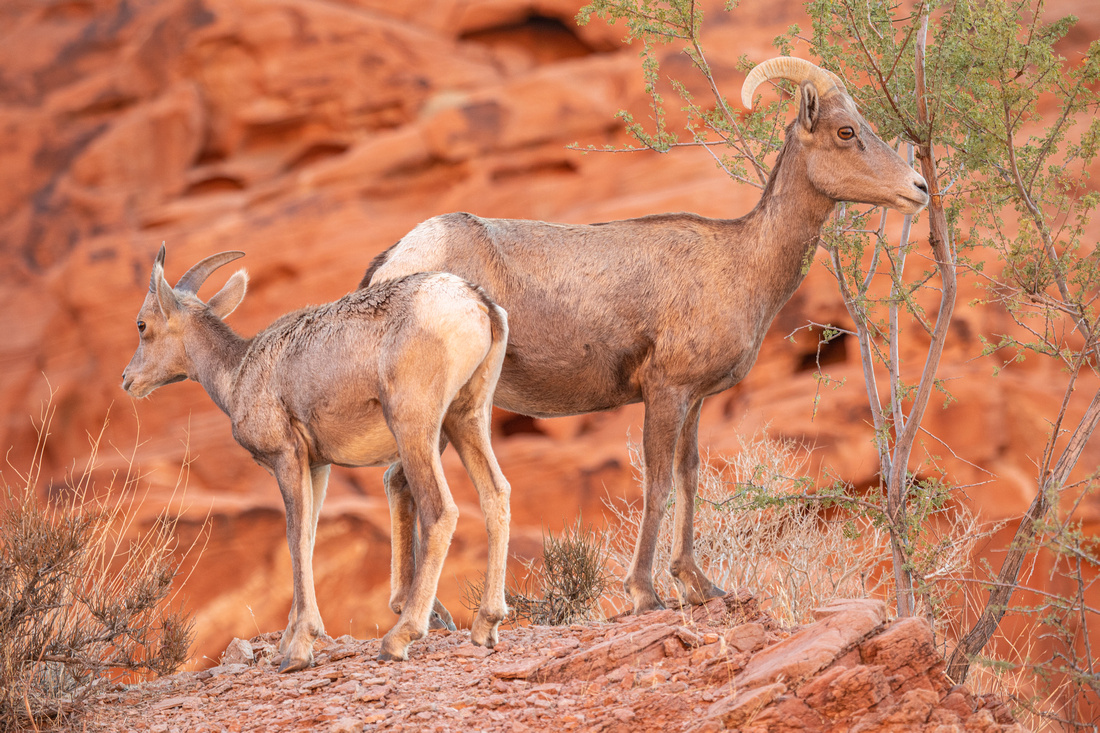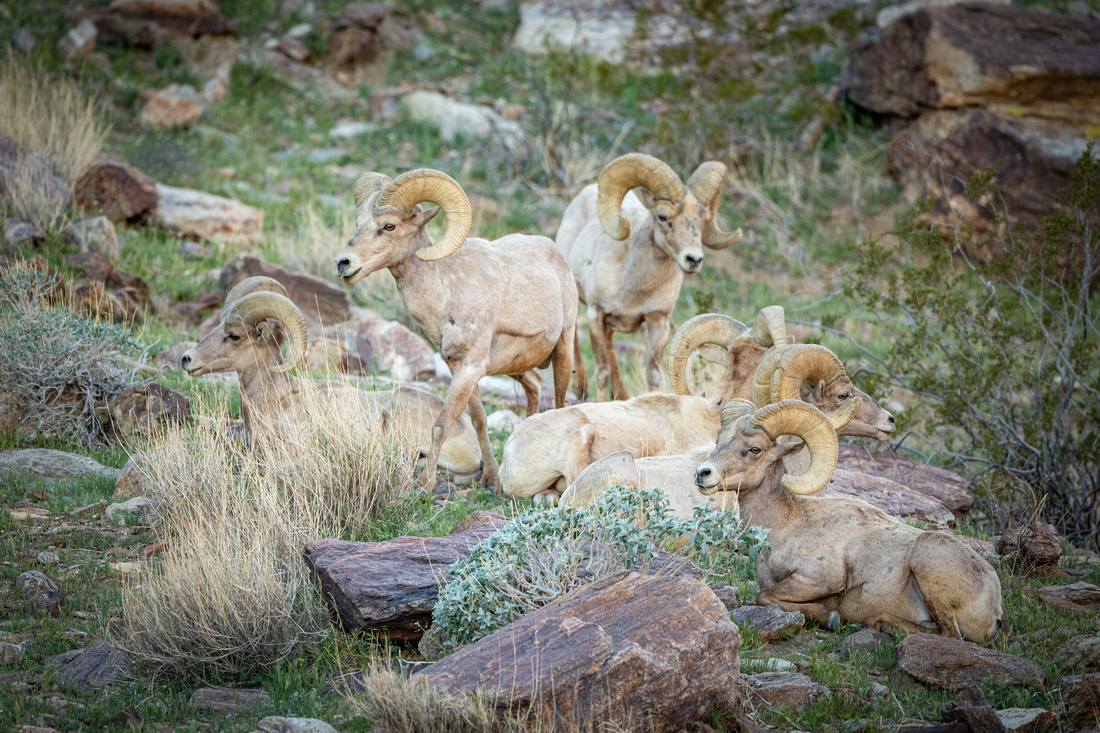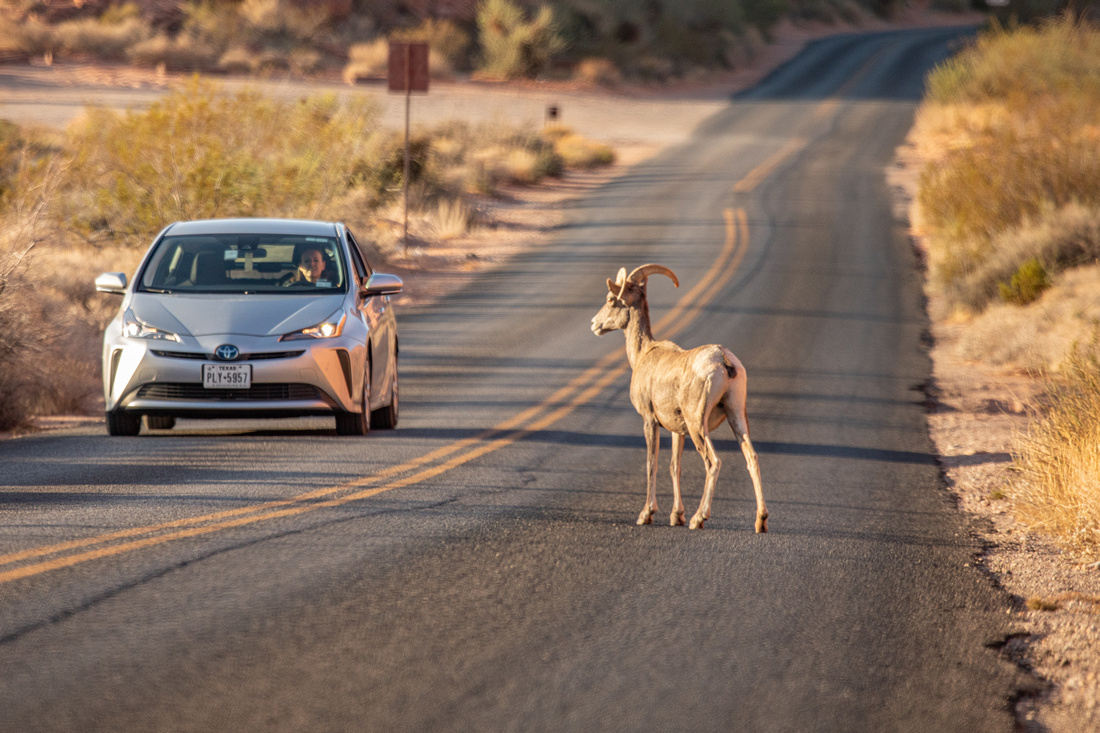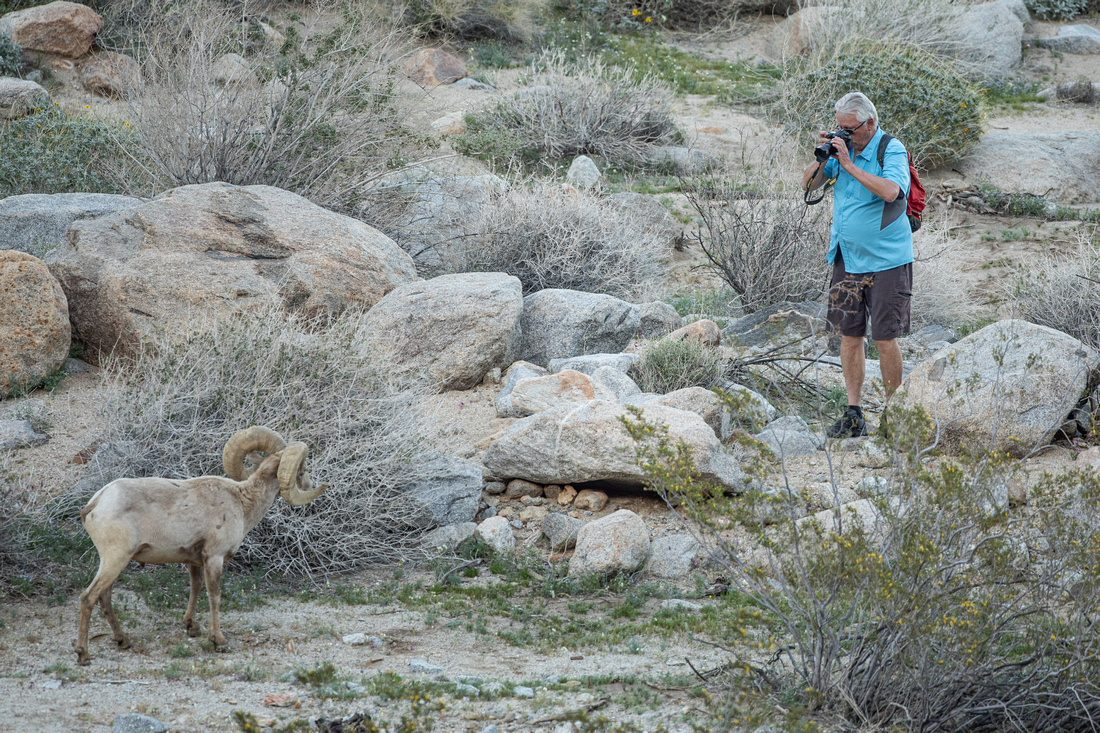Species highlight: Bighorn Sheep
Species Highlight: Bighorn Sheep
Text and photos by Heather Cline
The Bighorn sheep is recognized as one species, with three living subspecies: the Rocky Mountain bighorn sheep, Sierra Nevada bighorn sheep, and desert bighorn sheep.
Bighorn sheep played a prominent role in the indigenous cultures of North America. They were considered sacred and were associated with the sky and viewed as guardian spirits. They are commonly depicted across the American West on panels of Native American petroglyphs. The photo below is of two sculptures of Bighorns in Borrego Springs, a nod to the desert bighorn sheep that live in this area.
Size
- Adult male: 50-62 inches long / 150 - 200 lbs*
- Adult female: 50-62 inches long / 100 - 125 lbs
- Bighorn sheep stand between 32-40 inches from the ground to their shoulders
*Rocky Mountain bighorns, the largest of the three subspecies, have been known to get over 300 pounds.
Lifespan
Bighorn sheep lifespan ranges from 10-15 years with females tending to live slightly longer than males by a few years. Juvenile mortality ranges between 5 and 30 percent, but sheep that make it past the age of 2 have low mortality.
Anatomy
The bighorn sheep's body is compact and muscular, with pale to deep brown fur on the body with white on the muzzle, rump, and abdomen. They have a smooth outer coat of brittle hairs and short, fleece underfur. They go through a molting process in the summer months.
- Body temperature: Slightly warmer than humans at 101 degrees fahrenheit
- Vision: Their wide-set eyes are situated well forward on the head, providing a wide arc of exceptional vision
- Horns: Males have large, horns that can weigh up to 30 pounds can grow over three feet long with a more than a foot circumference at the base. Male horns become a full curl by 7-8 years of age. Females horns are short with a slight curve. Horns consist of a bony core with a permanent sheath of keratin. Sheaths grow from the base. Both rams and ewes use their horns as tools for eating and fighting.
Speed & Agility
Bighorn sheep can move over level ground at 30 miles per hour and scramble up mountain slopes at 15 mph. The bighorn sheep's cloven hooves are shaped to snag any protrusion on steep terrain, while a soft inner pad provides grip that conforms to different surfaces. They can jump up to 6 feet in the air.
In warmer months, bighorn sheep eat grasses, clover, and sedges with a transition to woody plants like willow and sage in colder months. In desert areas, bighorn sheep eat a wide variety of desert plants, including cacti.
Bighorn sheep are ruminants and have have a four-part stomach that enables them to quickly eat large portions before moving back to cliffs or ledges where they can thoroughly rechew and digest their food, safe from predators. From here, bacteria takes over, breaking down plant fibers for digestion. Bighorn sheep have adapted to a lack of available water through an evolved a nine-stage digestive process that allows for the maximum absorption of both nutrients and moisture from the grasses and other vegetation they eat. Even with this extremely efficient digestive process, desert bighorn sheep must seek out standing water to drink every two to three days.
Mature males spend most of their year in bachelor flocks apart from groups of females and young sheep. Young females generally remain in their mother's group for life. Males depart their mother's group around two to four years of age and join a group of rams. Bighorn sheep are social creatures and the period of time that a young ram wanders looking for a male herd, they may take up with other species out of loneliness.
It is during the mating season or "rut” that the rams join the female groups and engage in fierce competition to establish access rights to ewes. Their dominance hierarchy is based on age and body/horn size. Since male horns doe not reach a full curl until 7-8 years old, younger males usually do not rise to mating status until at least 7 as well.
Mating competition involves two rams running toward one another at speeds up to 40 miles an hour and clashing horns, producing a sound that can be heard a mile away. Their double-layered skulls help protect the brain from the blows of rutting combat. They also have a series of massive tendons that attach the skull to the backbone and allow the head to recoil as it absorbs the blow from another battling ram.
Rutting season occurs from July to December. Females breed once a year and have a gestation period of between five and six months. Females will find an isolated area to give birth to no more than two lambs. The young lambs quickly learn to walk and follow their mothers along the rocky terrains in which they must learn to successfully navigate. Mothers will nurse their lambs for four to five months. Male bighorn sheep play no role in raising the lambs.
Playing between lambs is most common during the spring months when food is plentiful.
Fun Fact: Bighorn sheep groups protect themselves from predators by facing different directions, allowing them to keep watch on their surroundings
Communication
Body posture and scent play important roles in social communication. Male horn size is a symbol of rank as well. Bighorn sheep rarely vocalize, but do sometimes bleat when seeking another animal, such as a mother seeking her lamb, and they may make a coughing sound when alarmed. They will also scent mark by rubbing eye glands on trees and rocks.
Range and habitat
The bighorn sheep range includes western mountainous regions of North America, ranging from southern Canada to Mexico. Their steep mountainous habitat, with ledges sometimes only two inches wide, provides cover from predators such as coyotes, golden eagles, mountain lions, bears, and Canada lynx. Most populations undergo seasonal movements, generally using larger upland areas in the summer and concentrating in sheltered valleys during the winter.
One of the subspecies of the bighorn sheep family, the desert bighorn sheep, have adapted to the arid desert mountain environment and range from the Mojave Desert of Nevada and California, eastward through the Sonoran Desert of Arizona and continue to be found in the Chihuahuan Desert of west Texas and northern Mexico. Desert bighorn sheep tend to have slightly smaller bodies, longer legs and lighter coats than their larger Rocky Mountain bighorn cousins; but the male's massive horns can be just as spectacular.
Bighorn sheep are quite effective at blending in with their environment, making them more challenging to spot.
Predators and Threats
The bighorn sheep were near extinction due to overhunting but have been recovering with the help of conservation efforts, but this species still faces challenges. During the nineteenth century, their numbers were estimated between 1.5 - 2 million but today, less than 85,000 remain.
Many states and environmental groups continue to work together to protect the fragile populations of North America's bighorn sheep. Today's biggest threats continue to be loss of habitat, illegal hunting and climatic changes.
Bighorn sheep are important to the ecosystem because they consume shrubs and grasses in their landscapes. They also provide a food source for large predators. The peninsular bighorn sheep located in Southern California have been protected under law since 1971 due to population declines attributed to habitat loss and modification, human disturbance, fragmentation due to roads, rail and tram construction, livestock grazing, disease, poaching, and fire suppression. The population was down to 400 when this law was enacted and their numbers improved to 955 by 2010 but remains extremely vulnerable.
One thing you do not want to do if you see a bighorn sheep is approach it. Not only is it dangerous for you, it can also alter the animals behavior, causing it to stop foraging for food or water. There is no excuse for this. All photos taken for this article (and my entire website) were taken with long range lenses and sometimes from inside my vehicle, using it as a blind. Please don't be like the guy in the photo below, who - despite multiple signs stating not to - walked way off the trail in Anza Borrego State Park to stalk and harass this Bighorn sheep. Despite the animal's multiple attempts to avoid him, the man just kept walking closer and closer so he could get what I am sure was a mediocre photograph. Don't be this guy. If you want to be a wildlife photographer - practice good ethics so we can all enjoy these beautiful creatures thriving in their natural environment.
I hope you enjoyed this post, and if you would like to see any of my other bighorn sheep photos, please check out my gallery.


